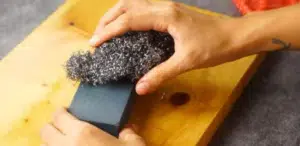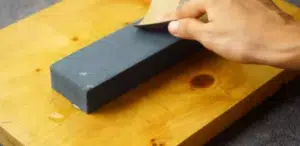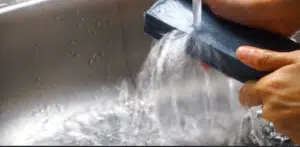A whetstone is one of the tools for sharpening knives and other blades. But the question on everyone’s lips is how to clean a whetstone after using it. Continue reading to get a rich answer and how you can maintain it.
To clean a whetstone, use hot water and a mild detergent to remove debris from cuts or food particles, thoroughly rinse away all traces of soap or detergent before drying the whetstone.
You can disinfect the whetstone surface by coating the surface with household vinegar and allowing it to sit for a few minutes. Rinse and dry the stone again after the vinegar has had time to evaporate. It is essential to take care of your stone for it to get optimal lifetime usage. Here are tips on how to clean your whetstone to give you years of excellent service.
What is a whetstone
 A whetstone is a sharpening stone used for sharpening knives, scissors, tools, and other items that have blades. The process works by using an abrasive material to grind the edge on the stone.
A whetstone is a sharpening stone used for sharpening knives, scissors, tools, and other items that have blades. The process works by using an abrasive material to grind the edge on the stone.
It contains several elements like silicon carbide, aluminum oxide, and garnet as they work in unison to give the stone its abrasive qualities. Whetstones come in different grits, with higher numbers indicating a greater coarseness.
Types of sharpening stone
There are several types of sharpening stones on the market today. These include oil stones, water stones, and diamond stones.
Oil Stone
Oil stones are a top-rated sharpening stone for good reasons, like being easy to use and relatively affordable. It is the most common sharpening stone as they come in various sizes, shapes, and grits.
There are three main sharpening grits today: extra-coarse (120-grit), coarse (240-grit), and fine (600-grit), with the most popular of them being 240-grit stones. Oil stones vary not just in their grit but also in their overall shape.
It removes steel quickly, and that is why it’s for experts and not beginners with little or no knowledge of sharpening a knife with it.
Water stones
Water stones are oil-wetted water-basalt stones. The advantage of Waterstones is that they are cheap, fast to sharpen knives, and easier to clean up after use.
Their superior quality is due to their tough composition and fine cutting ability to bring a dull knife back to life quickly. It is ideal for sharpening the smallest blades, such as razors, surgical instruments, and even serrated knives, and does an excellent job on kitchen knives.
Diamond stones
Diamond stones, also called whetstones, plate stones, and Indian stones, look and work the same. You can use them dry or with a lubricant, and if you choose the correct grit, it works wonders on any cutting edge. They all utilize hardened steel or carbide tips across the stone’s surface, and they all help keep knives and blades sharp and ready to use.
They offer a two-step process: They sharpen and refine. The first step is called grinding and will remove any metal above or below the knife blade’s edge evenly from both sides of the blade. The second step is called polishing which refines and polishes the newly ground edge till it is smooth as glass.
All diamond whetstone require soaking in water which makes it effective for both coarse and fine sharpening. It is faster than other types of stones but can be more expensive than other stone types.
Related Post: How to sharpen a convex edge
How to Clean a Whetstone

Step 1
Coat the stone surface with a thin layer of WD-40
Coat the sharpening surface of your stone with a thin layer of WD-40. After applying the WD-40, let the stone soak for about ten minutes.
Step 2
Remove the oil with fine steel wool
Use a wet rag to eliminate as much of the oil as you can. Gently rub the surface of the whetstone with a piece of fine steel wool, then wipe clean again with a piece of paper towel or dry cloth.
Step 3
Wipe the surface with a damp cloth
Wipe the surface with a damp cloth or paper towel in one direction over time, as it will help remove any remaining buildup on the stone. If the stone needs more extensive cleaning, use running water and vinegar, making sure that you never let water get into the holes of the stone. Let the stone air-dry completely after rinsing before storing it in its protective block.
Sharpening stone grits
The most crucial factor in choosing a sharpening stone is determining the grit size. Here are the dominant stone grits:
Sharpening stone grits are the numbers 250, 400, 600, 8000, and 15000. The higher the number, the finer or sharper the stone is going to be. Though grit size is measured differently depending on the kind of stone, generally, a higher number means a finer grit.
These stones come in various grits. The grit number refers to the fine sandpaper-like material on the stone; the higher the number, the “smoother” (less coarse) the stone is. The most commonly purchased sharpening stones are Arkansas stones, with sandpaper-like grits ranging from 100 to 1000.
It wears down over time like anything else you use on a semi-regular basis, but you don’t need to replace them often; you will only need to add new grit on a reasonably consistent basis. It can last longer, but that depends heavily on what you use it for and how well you maintain the stone.
Flattening a Sharpening Stone

To flatten your sharpening stones, Lie the stone down on a table, place another stone of similar size, weight, or thickness on top, then use some mallet to flatten the sharpening stone. You can purchase polyurethane or synthetic automotive bushings that are soft enough to depress some stones without hurting them but hard enough to stand up to reasonable poundage.
If you do not have tools at your disposal, lie the stone flat on a scrap of wood or other dense material so that it won’t roll around while you are pounding on it.
How to clean Japanese water stones
To clean Japanese water stones, soak them in lukewarm water for several minutes until all the crud has come loose. You can then rinse with fresh water and smooth out any rough spots with an old toothbrush.
Almost all Japanese Waterstones should be soaked in water periodically. If you’re using your stones daily and not cleaning them, they’ll accumulate a buildup of particles that eventually clog up the stone. Japanese Waterstones are softer than Western-style Waterstones, which allows the stone to wear down more quickly.
The buildup of particles can significantly slow down the sharpening process, so it’s worth it to clean your Japanese Waterstones weekly.
How to clean a diamond sharpening stone
There is only one way to clean a diamond sharpening stone is by using another diamond sharpening stone. If you are wiping it down with a rag, don’t do it as that will not do anything to help the stone. So, use another stone on it. Don’t try to use anything else as it is either not rough enough or the wrong material. For example, you need corundum for corundum, diamond for diamond.
It’s important not to destroy the abrasive properties of your diamond stone by using chemicals or heavy-duty cleaners, as this will damage the diamond pattern.
How to clean Arkansas stone

To clean Arkansas stone, put a lubricant oil on the stone and leave it for 2-5 minutes, then wipe the excess oil away from the surface with a cloth. It will help restore the stone surface like new. You can also use water, soap, detergent to clean the stone, but you must ensure the soap does not damage the surface.
To use another method, soak the stone in warm water with a bit of soap for about 15 minutes, after which you can scrub it with the grain and rinse it off, then allow it to air dry. Store in a cool, dry place for subsequent use.
How to resurface a sharpening stone
Resurfacing a sharpening stone is vital if it is starting to wear down or has lost its effectiveness. To resurface your sharpening stone, lay the sandpaper over its surface, then slowly pull it backward and forward at a low angle until you get the desired result. Repeat the process if necessary.
Trying to resurface your sharpening stone with medium-grit sandpaper will go a long way in bringing it back actively.
How to use a whetstone
- Take off any rust or corrosion using by using steel wool or a scouring pad before using it.
- Use oil or water on the surface before sharpening with it.
- Soak in water for about 5 minutes before using.
- Before using, make sure your stone is wet enough but not too wet.
- Use a smooth, consistent motion at a moderate pace and move in one direction when sharpening.
- Put water on the stone during grinding as it will keep the stone slippery and make sharpening easier.
How to maintain a whetstone
- Regularly wash it with water and vinegar.
- Wipe oil and dirt off the surface after every use
- Try using it regularly to keep the stone active.
- Always rub with honing oil to remove chipped metal left on the stone surface.
- Make sure you keep the stone damp while not in use.
- Clean the stone after every usage
How to tell if sharpening stone is oil or water
There are ways to tell if a sharpening stone is oil or water-based.
First, check the bottom of the stone, it should be listed on most oil stones, but water stones can be known by the scratch pattern on the stone bottom.
Lubricated Oil stones with oil and use it to wet or moisten the stone, making it easier to use. Don’t lubricate water stone with oil, but use water instead.
The major difference between oil and water is the way they work on your blade. Water will leave a slippery layer of metal behind, whereas oil will give your knife a more matte look in comparison.
How to oil a sharpening/whetstone
You might want to put enough oil on whetstone until they’re wet. But don’t let it be too much or too little; just enough will give the stone an oily surface. With a bottle of stone oil, put two drops per square inch of surface. Just make sure you don’t get any on your clothes to avoid stains.
To use another method:
- Soak a paper towel in water for 1-2 minutes, squeeze out most of the liquid.
- Dampen the structure of the whetstone with the slightly dampened paper towel.
- Dribble a little bit of cooking oil on the wet paper towel and spread it evenly over the stone’s surface.
With these steps, whetstone will retain its abrasiveness for a long time when it is properly oiled.
How to deglaze a sharpening stone
Deglazing is the process of removing dull and rough particles from a sharpening stone. It will allow sharpening and honing compounds and tools to glide more easily against the stone surface.
To deglaze a sharpening stone, using a spatula after applying water to the surface, sweep it back and forth with the edge of the spatula towards you. After this, and there are still stubborn bits of metal dust on the stone, then use some 400 grit wet & dry sandpaper to scrape them off.
This process will help break down and remove any hardened oils and dirt buildup on your stone and restore the abrasiveness. Repeat this process until you remove all residue, dirt, and metals. Store it in a cool, dry place.
Frequently Asked Questions
How do you clean diamond plate sharpening?
Clean a diamond plate sharpening razors with a leather conditioner. The oil in the conditioner will seal the pores on the blade and make it feel like new while also protecting it from rusting or becoming discolored. Any oil used to clean the blade will help, but use a leather conditioner for best results.
Do you use water on a diamond sharpening stone?
Never use water with diamond sharpening stones; it will ruin the cutting ability of the stone by depositing fine metal particles into the structure of the stone. Particles in the structure can scratch your knife blade as it cuts.
How do you keep a diamond sharpening stone?
Store diamond sharpening stone in a dry place and not humid environment; this will cause various issues like changing the way the stone interacts with a blade but won’t change shape.
Do I need to soak my whetstone?
You can soak whetstone but use water and household vinegar since it has a very neutral PH. Alternately, try soaking in some warm water with a bit of dish soap in it. Always rinse your whetstone after soaking, whether soapy or not.
How often should you flatten your whetstone?
It would be best if you flattened your whetstone when it is too coarse for regular use. However, each whetstone is unique, so expect variations based on the material and quality of the stone. The longer you use a sharpening stone, the more critical it is to flatten it from time to time.
Conclusion
A whetstone, like other stones, requires to be kept clean so that it doesn’t become too loaded with metal residual. That’s why this page on how to clean a whetstone will help you through it. Although a whetstone has a relatively small surface area, it needs to be taken care of after each use.
